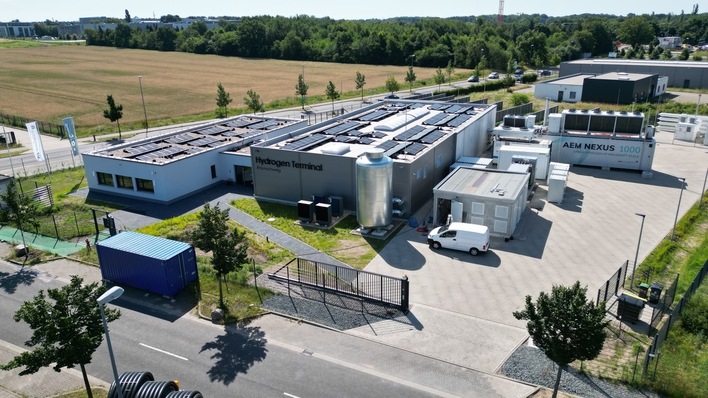The hydrogen industry faces the same challenges as other energy sectors: How can companies specifically train specialists for the necessary applications and techniques? Can the foreseeable shortage of skilled workers still be avoided? And do companies actually see a need to train their employees in the areas of the hydrogen economy?
In order to counteract these open questions with offers, various training centers are offering training programs for interested companies. The content is usually based on the essential stages of the H2 value chain. The fundamentals of generation, storage and infrastructure therefore play a central role. Also conveyed are the overarching importance of hydrogen for the energy transition as well as the goals of the German and European hydrogen strategy.
Basic knowledge also includes chemical and physical properties. The training centers thus teach the various technologies for the production and use of the energy source H2, for example in power-to-gas, in gas turbines or fuel cells. In addition, the integration into existing networks, the effects on distribution network operators and the far-reaching applications in the industrial, energy and mobility sectors are being intensively discussed.
Also the issue of safety is covered by many training programs. Most of them teach safe handling of hydrogen, explosion protection and the tightness of hydrogen systems. In some cases, the academies are planning to offer the building sector and heating technologies as well.
But which companies should actually be concerned with the topic of hydrogen now? The main influencing factor here is the energy intensity of a company’s processes. The steel or chemical industries are therefore often mentioned, which require such large amounts of energy that they cannot be electrified. Of course, this also includes companies that are directly involved in the planning of hydrogen projects and the development of the necessary infrastructure.
However, utilities or municipalities can also use hydrogen to expand a city’s energy portfolio in the direction of climate-friendliness and resilience. They are all therefore the target group of further education institutions. “These training courses should ensure cross-departmental awareness and training within the company, as well as be offered for qualified and technical personnel, energy officers, development engineers, production managers, occupational safety, quality control and management,” says Frederike Westenberger from the TÜV-Nord-Akademie.
In this way, basic knowledge about the topic can be conveyed, and future projects can be approached as future qualified on this basis. As particularly critical the training of the technical divisions that deal with research and development may be viewed.
Training for managers
To demonstrate the need for green hydrogen in a company, trained managers and administrators are also needed. They make resources available and support critical divisions. “One of the main challenges here is to reconcile the interests and the different perspectives of the companies and partners involved,” confirms Jan Heinze, managing director of the Hamburger Heinze Akademie. Therefore, in his opinion, managers should acquire deeper, in-depth knowledge.
Interest increasing
Directly “at the beginning of the ramp-up of hydrogen activities, we saw a great willingness to deal with the previously little-known properties and applications of hydrogen,” says Gunter Maetze from the Weiterbildungszentrum für innovative Energietechnologie (WBZU). At the WBZU in Ulm, participants in the area hydrogen mobility gain for example the Zertifikat für Gasanlagen in Fahrzeugen (certificate for gas drives in vehicles) in accordance with standard DGUV-FBHM-099.

Fig. 2: Peter Pioch from WBZU shows an H2 flame with a thermal imaging camera
The Haus der Technik (HdT) is likewise seeing a growing interest. This is motivated by social demands for more sustainability. The aim is to partially or completely change the energy supply. “To keep up with rapid technological developments, people are increasingly turning to us,” confirms Michael Graef, chief editor of the HdT-Journal.
This interest can also be seen at the Heinze Akademie. Since May 2021,135 participants have successfully completed the full-time course there. In the part-time IHK certificate course, 80 module exams were taken in one and a half years. The academy expects an increasing need for further training among engineers by 2027, for masters and technicians as well as commercial workers by 2029.
Framework conditions unsettled
Not all continuing education academies share this view, however: “From our experience, we observe a rather reserved level of interest. Of course, it may be that other offers on the market are more widely accepted. We assume that this is also due to the currently uncertain economic conditions and the wait-and-see attitude of many companies regarding the future development of the hydrogen economy,” says the BDEW-Akademie. Here, the still not clearly defined framework conditions are decisive.
A similar situation is recognized by the TÜVNordAkademie: “There is uncertainty due to a lack of legal and normative foundations as well as the economic viability of projects. These factors lead companies to wait and see whether they will actually invest in hydrogen technology and train their staff accordingly.”
Already a shortage of skilled workers
The reluctance of companies to offer hydrogen training from the bottom up goes hand in hand with the current situation in the labor market of the hydrogen economy. Here, there is already a shortage of skilled workers, but this is a fundamental phenomenon that is not only associated with the growth of this particular labor market. The shortage of skilled workers in the hydrogen economy can be traced back to the fundamental problem that, due to demographic change, there is a shortage of young talent everywhere.
The HdT sees a possible solution in the further qualification of existing staff. The WBZU recognizes that a gap in suitable qualification offers has now been closed for many subject areas with further training opportunities. “Things look a little different in the area of training. Here, the mills are grinding more slowly and it will still be a while before hydrogen topics find their way into curricula everywhere,” says Gunter Maetze.
The demand for qualified specialists will increase in the next few years according to the current trend. “If companies can no longer find skilled workers on the free market, we can further qualify those looking for work through resources and support from the Bundesagentur für Arbeit,” proposes Jan Heinze. This requires, however, some lead time.
H2 ramp-up increasing number of employed people
How labor demand and labor supply will come together for the hydrogen value chain in the coming years is the subject of a study by the Institut für Arbeitsmarkt- und Berufsforschung, a research institution of the Bundesagentur für Arbeit (federal work agency). Using scenario analysis, the influence of green hydrogen on the labor market until 2045 was examined. The scenarios compare the influence of a developed hydrogen economy with the influence of one that is missing.
The results show that the ramp-up of hydrogen has consistently positive effects on the number of employed people. In this scenario, by 2045 it will be an average of around 57,000 people higher than in the reference scenario. In absolute terms, the construction industry in particular is facing a higher demand for labor, which is accompanied by the expansion of renewable energies for the production of green hydrogen and the development of the hydrogen infrastructure.
There are also positive effects in the areas of architecture and engineering firms, technical investigations, childcare and teaching as well as in mechanical engineering. The research report shows more demand for administrative jobs. It becomes clear that there are already bottlenecks in many of these professional groups, which could delay the development of the hydrogen economy.
The study identifies the price of electricity as an important influencing factor and the associated costs of hydrogen and its derivatives ammonia and methanol. With 20 percent lower electricity prices for electrolysis abroad, the gross domestic product (GDP) would be an average of 7.7 billion euros by 2045 and the number of employed people would be an average of around 66,000 higher than in the reference scenario. If electricity prices were 40 percent lower, domestic GDP would be higher by an average of 11.2 billion euros and the number of employed people would be higher by an average of around 76,000 people.
The cheaper hydrogen can be made available, the higher the GDP and employment figures will be. However, it is also important to compare the costs of fossil fuels. If fossil fuels become more expensive, this will have a positive impact on the value of the hydrogen economy and thus on the number of people employed in this area. Government measures could also have a supportive effect here.
The shortage of skilled workers can be addressed
Clear is: The offer of training and further education programs exists. The educational centers offer what addresses the individual important areas of the topic of hydrogen. Nevertheless, the interest from companies is rather mixed. Although the energy industry is clear about the importance of the energy source, the political and economic conditions are a deterrent factor.
The hydrogen industry is probably heading towards the overall shortage of skilled workers that is affecting many sectors of the economy. The study of the Institut für Arbeitsmarkt- und Berufsforschung, however, also makes it clear that there is great economic potential waiting in hydrogen as an energy source. Once the ramp-up really starts, companies will no longer see any reason to hold back – and the shortage of skilled workers can still be counteracted.
Author: Fabian Kauschke









